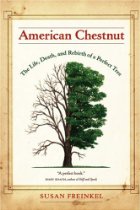American Chestnut: The Life, Death, and Rebirth of a Perfect Tree
By Susan Freinkel
In Susan Freinkel’s account of the history of Castanea dentata, the American chestnut, she brings the reader back to a time when this tree was the dominant species of the Eastern deciduous forest. Called a “perfect tree” by some because it grew fast, was long-lived, produced rot-resistant wood, and provided nutritious nuts each fall, this tree was decimated within forty years by the chestnut blight, a blight accidentally introduced in the early 1900s from Asia. The story of this species and its demise is also the story of our country’s industrial past and its current relationship with the land. What makes this book so interesting is the connection that Freinkel makes with both the people who depended on the tree 100 years ago and the people who are devoting their time and energy to the restoration and rebirth of this tree in the present day. The unique characters in the book, including the American chestnut, will live in the reader’s mind long after the book is closed.
This book is available at the Scott Horticultural Library.






Georgia W.M.Smallman
Posted at 13:58h, 19 JanuaryAlways fascinated by the history of the American chestnut tree, since my Girl Scout day camp group, at land adjacent to Thoreau’s Lake Walden, Concord, MA, in 1959, tried to identify a tall bush with large ovoid leaves. The local forester told us that it was a juvenile chestnut tree, still trying to survive the blight. In 1974, when studying Ecology with John Lyon, at Lowell State College (now University of Massachusetts, Lowell), we learned that the deadly blight was spead by vectors carried by winds, above a usual height of 15 feet. Am looking forward to obtaining this book.